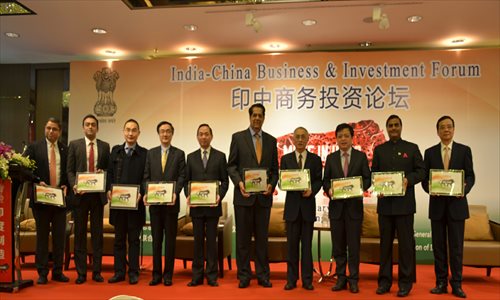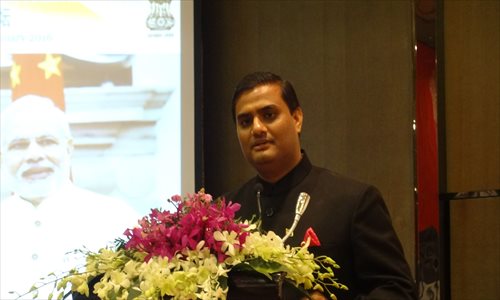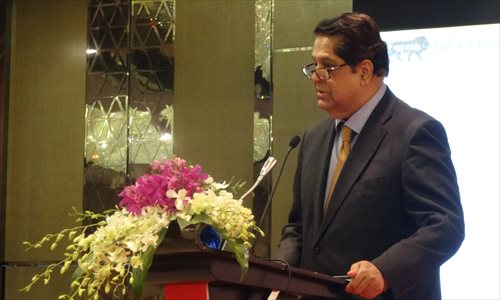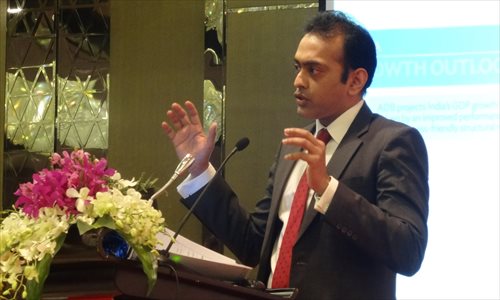HOME >> METRO SHANGHAI
India invites Chinese companies to participate in their economic upgrade
By Yang Lan Source:Global Times Published: 2016-1-17 18:28:01
Since becoming the world's largest exporter in 2009, the "Made in China" label has garnered a global reputation. These small labels, affixed to all products manufactured in China, represent the nation's strong manufacturing industry, surging economic growth and the 600 million manufacturing jobs that have lifted 500 million people out of poverty.
India, one of China's closest trading partners as well as one of its geographically closest neighbors, has more than any other country witnessed China's ascent this past decade. As such, in its first major event of 2016, the Consulate General of India in Shanghai invited over 150 CEOs from Chinese companies to share their insights, expertise and experiences as well as offer new business and investment opportunities in India.
Kundapur Vaman Kamath, president of the New Development Bank of BRICS Countries (NDB), first visited China in 1988. From his frequent trips here, he witnessed China's transformation from an agrarian society into a manufacturing and industrial powerhouse. Kamath believes that India, which is also largely agrarian, can replicate the success of the Chinese.
"There are four elements behind China's success that we can learn from: investment in agriculture, fisheries, and water management; rapid development of massive infrastructure; development of manufacturing and industry; and developing the service sector," said Kamath during the India China Business and Investment Forum in Shanghai.
Learning from China
In the vision of Indian Prime Minister Narendra Modi, by 2022 manufacturing should contribute to 25 percent of India's GDP. He launched the "Make in India" campaign in 2014 to transform the Indian sub-continent into a global design and manufacturing hub.
Prakash Gupta, the Consul General of India in Shanghai, has invited Chinese companies to attend the "Make in India" week in Mumbai this February, which will showcase growth potential and investment opportunities in India's manufacturing industries such as automobile, construction, electrical machinery, food processing and railways.
According to Gupta, India plans to build 15 million houses by 2022 and develop hundreds of smart cities and mega industrial corridors within the next five years. Furthermore, the country has a target of generating, transmitting and distributing 175 gigawatts of renewable energy in the next few years. It will also be opening metro rails in 50 cities and launching high-speed trains through various corridors.
"About 65 percent of India's GDP comes from the service sector. Manufacturing contributes only 15 percent. Ironically, most jobs do not come from the service sector, but from manufacturing," said Nagraj Naidu, Director General of Investments and Trade Promotion Division from the Ministry of External Affairs.
Learning from the headline-making success of China's November 11 national shopping day, which saw $9 billion in online sales in just 12 hours, the Indian government also hopes to bring a similar e-commerce revolution to India by providing more Internet access to its people.
India has 918 million mobile phone users and 402 million Internet users. Of these, 306 million access the Internet through mobile phones. For India, that means a potential 400 million e-commerce shoppers.
Recognizing this opportunity, the Indian government plans to build 700,000 kilometers in fiber optic networks over the next three years. It has already invested $5 billion in building rural broadband coverage for 250,000 villages, and over 400 universities currently offer free Wi-Fi access.
But what India is lacking, according to forum participants, is the necessary technologies and hardware such as portable devices, 4G networks and cyber security that China - the world's largest user and consumer of mobile phones and the Internet - has an abundance of. In this regard, the Indian government is hoping to ask Chinese companies to transfer their technology over the border.
"India today is what China was in the 1990s. Chinese enterprises and businesses understand the potential in India," said Naidu.
Kamath at NDB concurs. "Developing countries look for solutions which are cost-effective. Unfortunately when we look for solutions from developed countries, they are not cost-effective. That is why I think a partnership between China and India is worthwhile."
Tremendous influence
As the two largest developing countries in the world, China and India are complementary in their economic structures. The combined populations of both nations account for one-third of the world population, and the cultures, economies and politics of both have a tremendous influence at regional and global levels.
In the eight months between Chinese president Xi Jinping's visit to India in September 2014 and President Modi's visit to China in May 2015, over 40 business-to-business Memorandum of Understanding (MOU) were signed between the two countries. The economic potential of these MOUs equals more than $50 billion.
Between January and October of 2015, the bilateral trade volume between Shanghai and India reached $6.6 billion, with 208 projects worth $300 million in foreign direct investment from India to Shanghai by the end of November. Companies from Shanghai are considered among the best candidates to invest in India.
"Shanghai is one of China's economic centers. It has a well-developed industrial system in traditional areas such as infrastructure, communications, machinery manufacturing, and cooperation capacities in high-tech industries," said Zhou Taitong, Vice Chairman of the Chinese People's Political Consultative Conference (CPPCC) Shanghai Committee.
"A number of Chinese firms will participate in the 'Make in India' week to share their knowledge and experiences doing business in India," said Yang Jianrong, Chairman of China Council for the Promotion of International Trade (CCPIT) Shanghai. "We all benefit from this cooperation."




Newspaper headline: The dragon & the elephant
India, one of China's closest trading partners as well as one of its geographically closest neighbors, has more than any other country witnessed China's ascent this past decade. As such, in its first major event of 2016, the Consulate General of India in Shanghai invited over 150 CEOs from Chinese companies to share their insights, expertise and experiences as well as offer new business and investment opportunities in India.
Kundapur Vaman Kamath, president of the New Development Bank of BRICS Countries (NDB), first visited China in 1988. From his frequent trips here, he witnessed China's transformation from an agrarian society into a manufacturing and industrial powerhouse. Kamath believes that India, which is also largely agrarian, can replicate the success of the Chinese.
"There are four elements behind China's success that we can learn from: investment in agriculture, fisheries, and water management; rapid development of massive infrastructure; development of manufacturing and industry; and developing the service sector," said Kamath during the India China Business and Investment Forum in Shanghai.
Learning from China
In the vision of Indian Prime Minister Narendra Modi, by 2022 manufacturing should contribute to 25 percent of India's GDP. He launched the "Make in India" campaign in 2014 to transform the Indian sub-continent into a global design and manufacturing hub.
Prakash Gupta, the Consul General of India in Shanghai, has invited Chinese companies to attend the "Make in India" week in Mumbai this February, which will showcase growth potential and investment opportunities in India's manufacturing industries such as automobile, construction, electrical machinery, food processing and railways.
According to Gupta, India plans to build 15 million houses by 2022 and develop hundreds of smart cities and mega industrial corridors within the next five years. Furthermore, the country has a target of generating, transmitting and distributing 175 gigawatts of renewable energy in the next few years. It will also be opening metro rails in 50 cities and launching high-speed trains through various corridors.
"About 65 percent of India's GDP comes from the service sector. Manufacturing contributes only 15 percent. Ironically, most jobs do not come from the service sector, but from manufacturing," said Nagraj Naidu, Director General of Investments and Trade Promotion Division from the Ministry of External Affairs.
Learning from the headline-making success of China's November 11 national shopping day, which saw $9 billion in online sales in just 12 hours, the Indian government also hopes to bring a similar e-commerce revolution to India by providing more Internet access to its people.
India has 918 million mobile phone users and 402 million Internet users. Of these, 306 million access the Internet through mobile phones. For India, that means a potential 400 million e-commerce shoppers.
Recognizing this opportunity, the Indian government plans to build 700,000 kilometers in fiber optic networks over the next three years. It has already invested $5 billion in building rural broadband coverage for 250,000 villages, and over 400 universities currently offer free Wi-Fi access.
But what India is lacking, according to forum participants, is the necessary technologies and hardware such as portable devices, 4G networks and cyber security that China - the world's largest user and consumer of mobile phones and the Internet - has an abundance of. In this regard, the Indian government is hoping to ask Chinese companies to transfer their technology over the border.
"India today is what China was in the 1990s. Chinese enterprises and businesses understand the potential in India," said Naidu.
Kamath at NDB concurs. "Developing countries look for solutions which are cost-effective. Unfortunately when we look for solutions from developed countries, they are not cost-effective. That is why I think a partnership between China and India is worthwhile."
Tremendous influence
As the two largest developing countries in the world, China and India are complementary in their economic structures. The combined populations of both nations account for one-third of the world population, and the cultures, economies and politics of both have a tremendous influence at regional and global levels.
In the eight months between Chinese president Xi Jinping's visit to India in September 2014 and President Modi's visit to China in May 2015, over 40 business-to-business Memorandum of Understanding (MOU) were signed between the two countries. The economic potential of these MOUs equals more than $50 billion.
Between January and October of 2015, the bilateral trade volume between Shanghai and India reached $6.6 billion, with 208 projects worth $300 million in foreign direct investment from India to Shanghai by the end of November. Companies from Shanghai are considered among the best candidates to invest in India.
"Shanghai is one of China's economic centers. It has a well-developed industrial system in traditional areas such as infrastructure, communications, machinery manufacturing, and cooperation capacities in high-tech industries," said Zhou Taitong, Vice Chairman of the Chinese People's Political Consultative Conference (CPPCC) Shanghai Committee.
"A number of Chinese firms will participate in the 'Make in India' week to share their knowledge and experiences doing business in India," said Yang Jianrong, Chairman of China Council for the Promotion of International Trade (CCPIT) Shanghai. "We all benefit from this cooperation."

The India-China Business and Investment Forum held in Shanghai

Prakash Gupta

Kundapur Vaman Kamath

Nagraj Naidu
Photos: Courtesy of the Consulate General of India in Shanghai and Yang Lan/GT
Newspaper headline: The dragon & the elephant
Posted in: Metro Shanghai